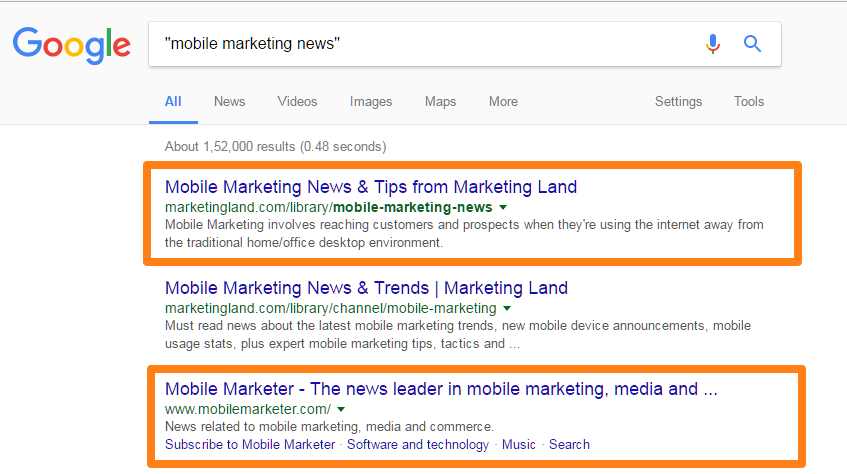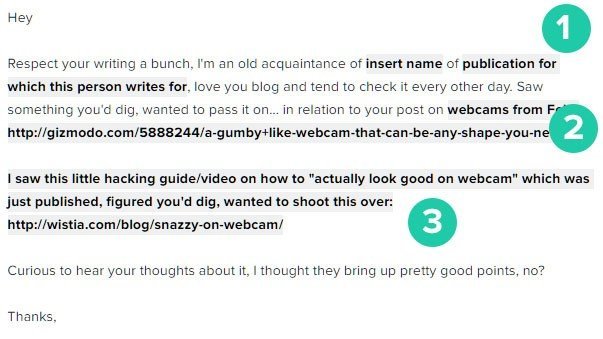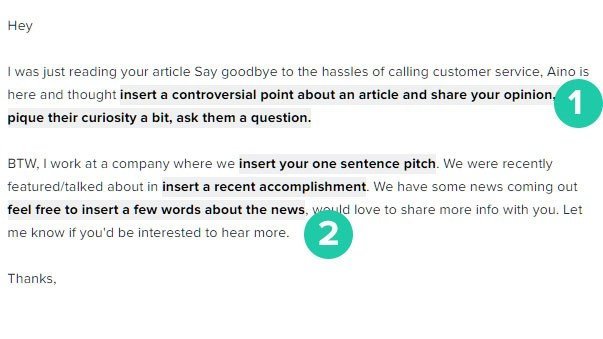A while ago, SEO expert Brian Dean, from whom I had purchased a course, introduced me to Dmitry Dragilev.
Over the past nine years, Dragilev has published 1400+ articles on major blogs and publications and single-handedly grew a startup to 40M page views through press outreach which got acquired by Google back in 2014. So he knows how to pitch journalists to get them interested in your project.
About Dimitry Dragilev
Dmitry is the founder of JustReachOut, a software tool used by 4000+ professionals and small businesses (as well as major corporations such as Airbnb, HubSpot, Chess.com, Nickelodeon) to pitch relevant journalists and get press coverage without the help of PR firms.
Asked to share his expertise on using LinkedIn to prospect and outreach to journalists, bloggers and influencers, Dmitry says:
As a startup founder, I know that young startups are desperate to get featured in prominent media outlets and top blogs. Getting fast exposure is imperative to your growth but most of us don’t have the money to hire a PR firm
Even if you have a great PR tool which doesn’t cost much, you still might end up struggling to reach out to press with your DIY methods.
Luckily, if you understand how PR pitches work, you can do it yourself successfully!
Regarding journalists
I love what freelance journalist Rosie Spinks has to say on hacking your own PR. She says, for PR to be successful, it actually requires a basic understanding of how journalism works.
Journalists are usually looking out for the “so what”. They are not so interested in the fact that you launched a company but would be intrigued if your company addressed some larger trend that is not usually talked about.
Journalists are also very active on social media to connect with new people and contacts on a daily basis.
How to pitch journalists over LinkedIn to get a response
In this post, you will learn how to connect and build a relationship with journalists interested in your story over LinkedIn.
Once you have built a rapport with a journalist, you can use it as a stepping stone to make a pitch and get a positive response.
So let’s get down to business.
1. Nail your one sentence value proposition
A value proposition is what your product/service does that sets it apart from the competition.
You’ll be using this to introduce yourself to a journalist through an InMail or LinkedIn introduction (more about that later).
Use this template below (it’s tried and tested):
My Company <name> is developing <offering> to help <target audience> <solve a problem> with <a secret sauce>.
This template, created by Adeo Rossi of Founder Institute is pure gold. Just fill in the blanks and keep away from jargon.
Here are a few good examples of one sentence pitches using this template:
Airbnb: Find a place to stay.
Airto: Airto, is developing a web-based social seating check-in platform to help air travellers see who is on board their flight and use Facebook and LinkedIn to assign all flight seats with one click.
In both cases, the pitch is clear yet concise and you instantly understand what the company does without having to think too hard.
Now, here’s an example of a clunker:
We are a web analytics platform designed to give your business intelligence to close your next deal.
This pitch is short and that’s good but it’s not clear on what this thing does and who will use it for which purpose.
Your one sentence pitch not only needs to be brief but also to convey what you do and how that helps your target audience in plain simple words.
As Rosie puts it:
You should be able to sum that up in ten words, at most, preferably without using any buzzwords
If a journalist is clueless about what your company does within 30 seconds of opening your email, they’re sure to hit delete.
2. Build your contact list of relevant journalists
You want to find journalists interested in what your startup does.
Find reporters through LinkedIn
Check your LinkedIn connections, select all the reporters and journalists from them and make a spreadsheet.
Write down the name of the journalist, the publication they work for and the industry they cover. Jot down also links to a few recent articles they have written related to your niche.
You can also add the Twitter profile and a link to their personal blog or website (if available).
The journalists’ LinkedIn and Twitter profile will give you a fair idea about the industry and topics they write about, which publication they work for and whether they write regularly on the industry in which your product/service is based.
Make use of LinkedIn groups
Also, check LinkedIn groups they have joined to understand whether your pitch will interest them or not. There is no point in pitching to a food critic if you have developed a time tracking app.
You would be better off talking to a technology reporter or someone who covers productivity and employee management.
If the list of journalists from your LinkedIn connections is limited, don’t despair.
Find reporters using Google search
In Google Search, type the industry your company is in and toggle to the News tab. Google News tab will show you the most recent articles and/or publications that have written about your topic.
Journalists who recently wrote stories about your industry will most likely be interested in what you do.
For example, if you’re targeting journalists that write about mobile marketing start-ups, use a query like “mobile marketing” in Google search.

Once you find a few promising results, open each link and shift through the articles to figure out the names of journalists who write about your subject (mobile marketing) on these sites.
You ideally want to find authors who write regular news stories (not features) and have multiple articles.
If they wrote an article as a one-off, chances are they may not cover this topic again so it may not be worth the effort to add them to your list.
In our example, you can see that the first result – MarketingLand – has several articles on mobile news from Greg Sterling.

Looking at Greg’s bio on one of the articles, we can see that he is a contributing editor to MarketingLand.
Given the frequency of his contributions and coverage area, he would be a good candidate to pitch.
Plug the name of these journalists in your spreadsheet, along with the publication name, links to recent articles, industry covered, Twitter & LinkedIn profile, blog/website link.
This is tedious work but is definitely error-free. You can also use a tool like JustReachOut to automate the entire research process.
3. Get on the journalists’ radar
It is essential to build a relationship with journalists who have never heard about you before going ahead and make your pitch.
This is similar to how retargeting works in the ad world. Does it sound familiar visiting a website and being followed by and ad everywhere?
Retargeting makes the company’s name sink in into the subconscious.
Use these simple steps to imperceptibly get the attention of a journalist:
- If you don’t have a connection, follow the journalist on LinkedIn as well as other social media like Twitter and Facebook
- Retweet /share their posts that would be of interest to your audience
- Leave a meaningful comment or questions on articles they have shared on different social media platforms
- Make sure your comment relays on your personal experiences or an interesting piece of knowledge
- Share useful articles, relevant studies that would be of interest to a journalist.
- If a few key journalists are part of a LinkedIn group, join it. Monitor and participate in group discussions to provide expert advice. This way the journalist will get to know you and your start-up. Message other group members even if you have no connection with them (you can send 15 free messages per month to other members with whom you are not connected).
- Provide substantive answers to questions posted by them on various groups
- If you have the information, give a journalist an inside scoop about something related to their industry that is going to happen without any strings attached
- Provide valuable help (example: if they are travelling somewhere, throw together a brief guide for them about the best places to eat/see)
What happens after contacting with journalists through LinkedIn
Here’s what Rebecca Grant, a former writer at Venture Beat, has to say about building relationships first:
You — a PR person, employee, or entrepreneur — reach out to the press when you need coverage. That reciprocated is rare. If you have a tip or an idea for an article that *gasp* doesn’t involve you, share it with a journalist. We are always on the prowl for good stories
Once you have built an initial relation with a journalist, see how the two of you are connected on LinkedIn.
If they are not your first-degree connections, ask one (or more) of your connections to introduce you, so you’re not coming out of the dark.
It is simpler to get an introduction if you keep your requests to second-degree connections, where you and the person you’d like to be introduced to have someone in common.
Use your one sentence pitch when asking your common connection to introduce you to a journalist.
4. Strike up a meaningful conversation through a carefully crafted message
Once you have taken the steps mentioned above to initiate a connection, use that context to strike up a conversation through an InMail or direct message.
These messages are primarily for strengthening the connection with the journalist so when you are ready to pitch, they are more likely to open your email and consider it.
Here are some examples of what to write:
1. The “helpful article” message
You recently read an in-depth article by your target journalist.
There’s a good chance the journalist is interested in learning a bit more about that topic.
In this message, you focus on sharing relevant content about the topic with the journalist. Don’t forget to link to the actual content you’re referencing.
Suggest a book or a white paper, maybe send a few links to articles written by competition.
It’s a great way to get kick-start a conversation.

2. The “upcoming news” message
Journalists love a scoop.
In this message, you connect the journalist’s recent work to an upcoming event related to your business.
Refer to the journalist’s recent article so they know that you’re familiar with their work. Then insert a controversial point about the article or ask them a question.
Next, casually state that you work for X company where you <put your one sentence pitch>.
Then mention a recent accomplishment about you or your company (this also acts as a great social proof). Then promise some upcoming news and hint that it might be exclusive.
This will work like a charm provided you actually have some ‘interesting’ scoop for the journalist.

3. The “spelling mistake” message
This is a different approach but gets the job done.
Pointing out spelling mistakes or typos in an article is a good way to break the ice.
It gives you an excuse to message the journalist and offer some suggestions and ideas. Don’t be afraid to come across as a grammar Nazi.
Most journalists appreciate when someone points out their mistakes. Just remember: mention only 2-3 mistakes and do mention some detail from the article.
To continue the conversation, you can close with something of the lines of: “Which article are you working on next?”

4. The “followed your advice” message
If you’ve tried something a journalist wrote about and got good results from it, let them know. Journalists love to know if their writing had an actual impact on people.
However, this has limited use and can be time-consuming since you’ll have to follow the advice and track the results. So limit it to top journalists or influencers you want to develop a long-term relationship with.
I have compiled actual real life example and email templates I have used for most of these angles and more here and here. “
We need to thank Dmitry for this very detailed analysis.

Make your LinkedIn profile stand out
However, ideally, before launching oneself in this procedure, it is crucial to set one’s foundations by creating a strong Professionally Crafted and Fully Optimized LinkedIn Presence:

- Upon approaching journalists you will be viewing their profile, and they, in turn, will also visit your profile to get the necessary information ON YOU (background, knowledge, skills, even character).
- Just like in all other professional fields, professionals in press and media are on the lookout on the LinkedIn platform for specialists.
Over to you now
Now you have built a solid LinkedIn profile, got the conversation ball rolling and might have even provided the journalist with some value.
It’s time to make a direct pitch for an interview or seek a mention about your product/service in their publication.
If the conversation goes back and forth several times, then you may not even have to make a hard pitch.
Remember: journalists are always on the lookout for interesting stories. Since you’ve already connected with them, they’ve heard something about your product/service and may, therefore, decide to take the relationship a step further.
Do you know any other strategies to contact with journalists? Did you find this article useful? Let me know what you think by leaving your opinion in the comments below.
For more business tips, check our entrepreneurship section and subscribe to our weekly newsletters.






